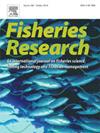Assessment of mortality during trap and transport in adult European eel
IF 2.2
2区 农林科学
Q2 FISHERIES
引用次数: 0
Abstract
Many fluvial water systems suffer from reduced or completely disrupted connectivity due to human activities, causing negative effects for species and ecosystems. Artificial transport past migration barriers, so called trap and transport, can be used as a management tool to mitigate fish population declines. The efficiency of trap and transport is, however, rarely evaluated, in particular for downstream transport of catadromous species such as the European eel. In this study we analysed seven years of trap and transport data (2016–2022), encompassing nearly 58,000 transported adult eels, to evaluate mortality during all steps of the trap and transport process (i.e., mortality in fishing gear, during holding, and during transport). We found that mortality rates were generally low for all steps, 0.2–1.4 % in the fishing gear, 0.6–2 % during holding, and 0.03–0.17 % during transport (percent per year on average), compared to expected mortality in turbines (estimated turbine mortality in the investigated area: 70% to >99 %). The factors affecting mortality differed across the trap and transport steps, with year, season (day of year), temperature, and mortality in the previous step (i.e., indicative of general stress in the previous step, and/or poor condition) being the factors having an effect. We conclude that trap and transport may cause relatively low mortality compared to turbines, but since it requires maintenance and human interference, restoration of connectivity should be the long-term goal.
成年欧洲鳗鱼在捕虏和运输过程中的死亡率评估
由于人类活动,许多河流水系的连通性减少或完全中断,对物种和生态系统造成负面影响。人工运输,即所谓的陷阱和运输,可以作为一种管理工具来缓解鱼类数量的下降。然而,捕集器和运输的效率很少得到评估,特别是对像欧洲鳗鱼这样的地生物种的下游运输。在这项研究中,我们分析了7年的陷阱和运输数据(2016-2022年),其中包括近58,000条运输的成年鳗鱼,以评估陷阱和运输过程中所有步骤的死亡率(即渔具,持有和运输期间的死亡率)。我们发现,与涡轮机的预期死亡率相比,所有步骤的死亡率普遍较低,渔具中的死亡率为0.2-1.4 %,保持期间的死亡率为0.6-2 %,运输期间的死亡率为0.03-0.17 %(平均每年百分比)(调查区域的涡轮机估计死亡率为70%至99 %)。在不同的捕集和运输步骤中,影响死亡率的因素不同,年份、季节(一年中的一天)、温度和前一步的死亡率(即表明前一步的普遍压力和/或条件差)是影响死亡率的因素。我们的结论是,与涡轮机相比,陷阱和运输可能导致相对较低的死亡率,但由于它需要维护和人为干扰,恢复连通性应该是长期目标。
本文章由计算机程序翻译,如有差异,请以英文原文为准。
求助全文
约1分钟内获得全文
求助全文
来源期刊

Fisheries Research
农林科学-渔业
CiteScore
4.50
自引率
16.70%
发文量
294
审稿时长
15 weeks
期刊介绍:
This journal provides an international forum for the publication of papers in the areas of fisheries science, fishing technology, fisheries management and relevant socio-economics. The scope covers fisheries in salt, brackish and freshwater systems, and all aspects of associated ecology, environmental aspects of fisheries, and economics. Both theoretical and practical papers are acceptable, including laboratory and field experimental studies relevant to fisheries. Papers on the conservation of exploitable living resources are welcome. Review and Viewpoint articles are also published. As the specified areas inevitably impinge on and interrelate with each other, the approach of the journal is multidisciplinary, and authors are encouraged to emphasise the relevance of their own work to that of other disciplines. The journal is intended for fisheries scientists, biological oceanographers, gear technologists, economists, managers, administrators, policy makers and legislators.
 求助内容:
求助内容: 应助结果提醒方式:
应助结果提醒方式:


